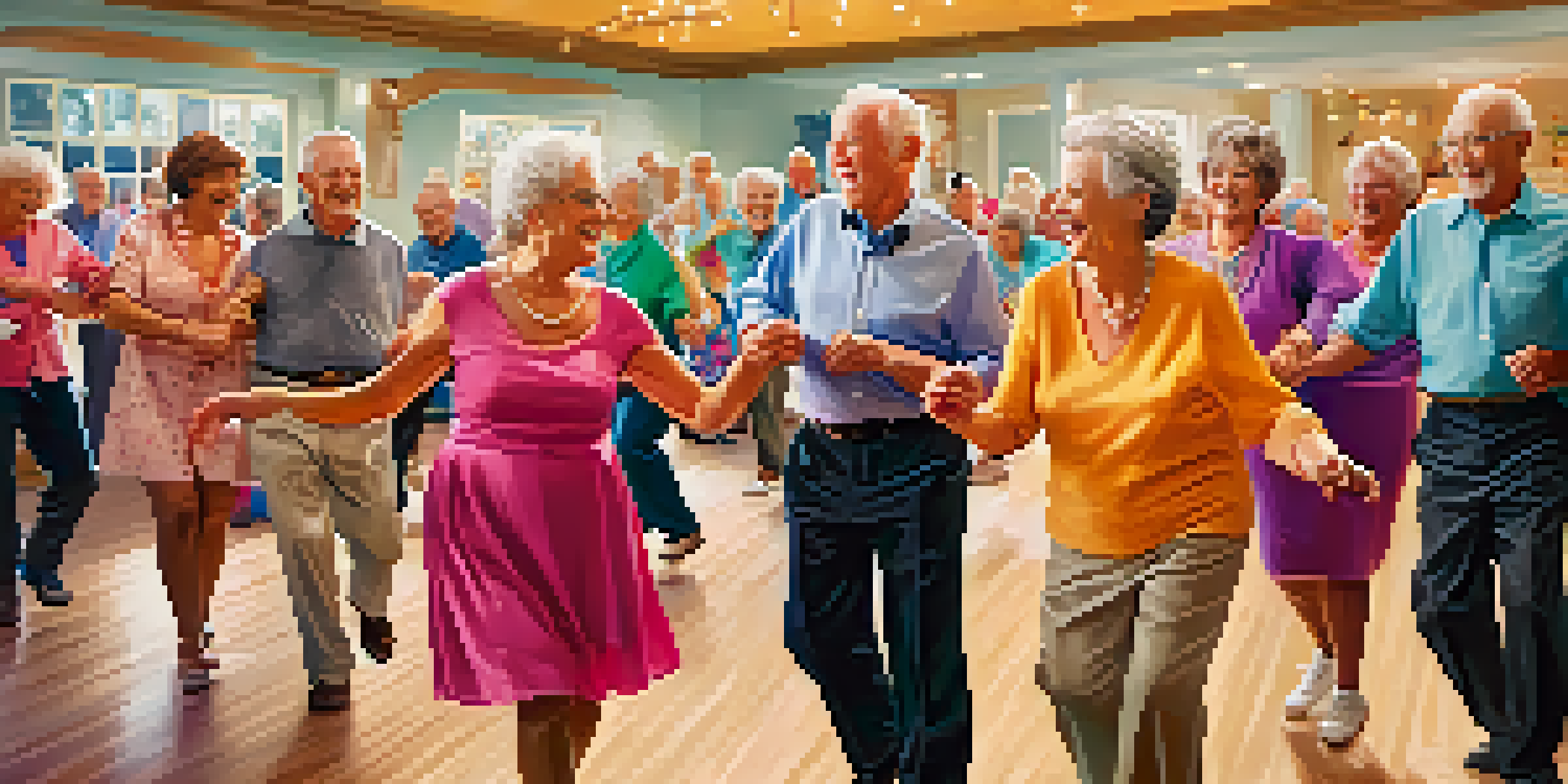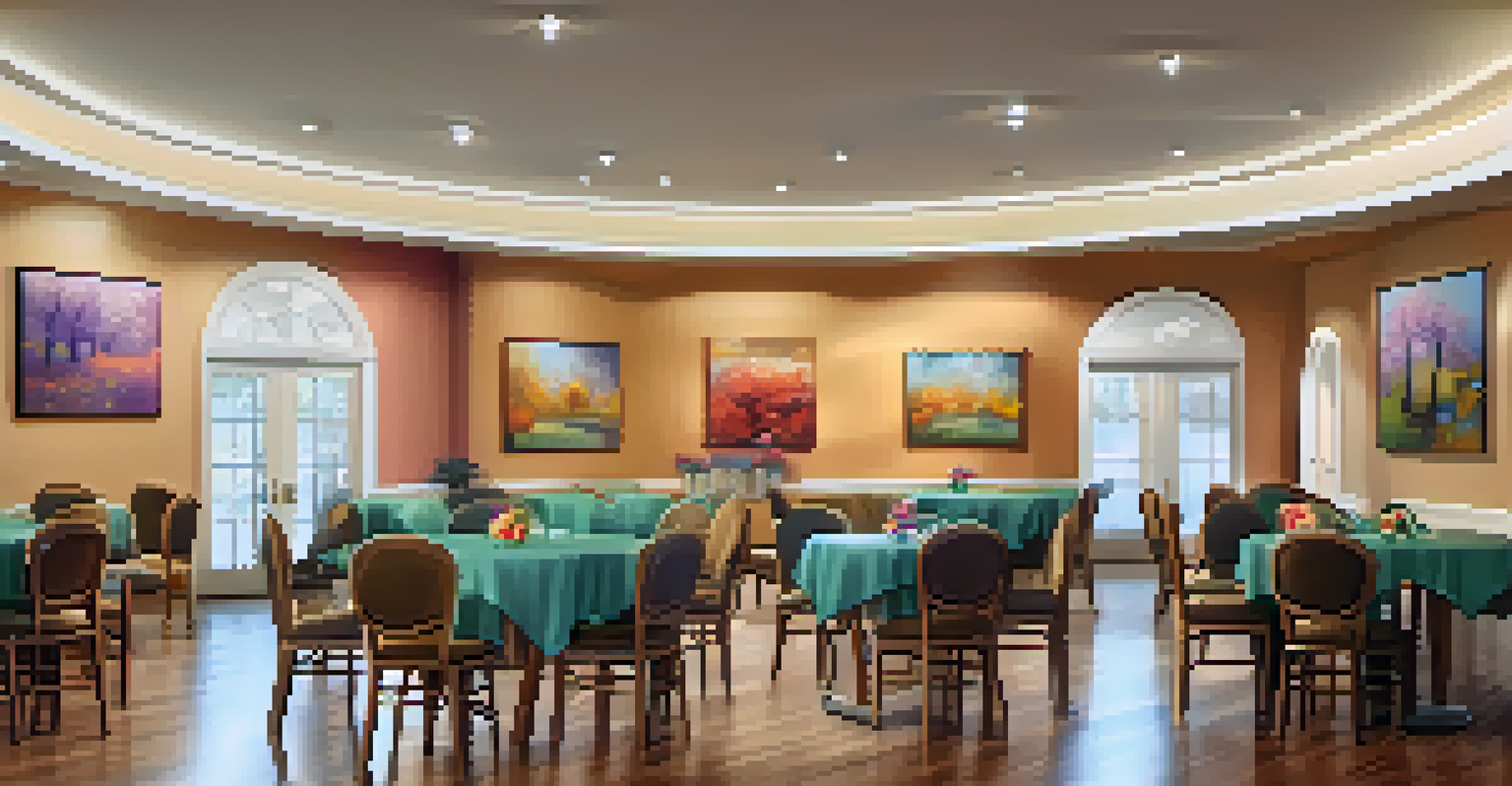The Role of Dance in Enhancing Mental Health for Seniors

Understanding the Connection Between Dance and Mental Health
Dance is more than just a fun activity; it has profound effects on mental well-being. For seniors, engaging in dance can help combat feelings of loneliness and depression, offering a sense of community and belonging. The physical movement involved in dancing releases endorphins, the body's natural mood lifters, which can significantly enhance emotional health.
Dance is the hidden language of the soul.
Moreover, dance stimulates cognitive function by requiring memory and coordination, keeping the mind active. This engagement can delay the onset of cognitive decline, making it a fantastic tool for maintaining mental acuity as we age. Think of dance as a workout for both the body and the brain, promoting overall health.
In essence, the connection between dance and mental health is not just a fleeting trend; it's a powerful combination that can lead to happier, healthier lives for seniors. By embracing dance, they can experience a holistic improvement in their quality of life.
Social Interaction: Building Connections Through Dance
One of the most significant benefits of dance for seniors is the opportunity for social interaction. Group dance classes or social dances provide a platform where seniors can meet new people and forge friendships. This social aspect is crucial, especially as isolation can negatively impact mental health.

Engaging in dance with others fosters a sense of camaraderie and support, creating an environment where individuals feel valued and connected. Sharing laughs and experiences on the dance floor can lead to lasting bonds, which are essential for emotional well-being. It's like having a second family that encourages you to move and groove.
Dance Boosts Seniors' Mental Health
Engaging in dance can significantly enhance mental well-being for seniors by combating loneliness, releasing endorphins, and stimulating cognitive function.
Additionally, these social settings can help reduce anxiety and promote a sense of belonging. By participating in group dances, seniors can feel part of something bigger than themselves, which can be incredibly uplifting.
Physical Benefits of Dance That Boost Mental Health
The physical benefits of dance are well-documented, and they play a pivotal role in enhancing mental health. Regular physical activity, including dance, can improve strength, flexibility, and balance, which are vital for seniors. When seniors feel physically capable, it often translates into increased confidence and a more positive outlook on life.
To watch us dance is to hear our hearts speak.
Moreover, dancing helps improve cardiovascular health, which can reduce the risk of depression and anxiety. The act of moving rhythmically to music not only engages the muscles but also gets the heart pumping, releasing those feel-good hormones. It’s a win-win situation: better health and better mood.
In short, the physical uplift that dance provides can significantly impact mental health, making it an effective, fun option for seniors looking to enhance their overall well-being.
Expressing Emotions Through Dance: A Unique Outlet
Dance offers a unique avenue for seniors to express their emotions, which can be particularly beneficial for mental health. When words fail, movement can convey feelings of joy, sadness, or even grief, allowing for emotional release. This expressiveness can be therapeutic, helping seniors process their emotions in a constructive way.
Additionally, dance can serve as a form of storytelling, where individuals can connect their life experiences through movement. Many seniors find that recalling memories through dance helps them feel more grounded and can even spark joy from past experiences. It's like a dance of memories that keeps the spirit alive.
Social Connections Through Dance
Group dance classes provide seniors with essential social interaction, helping to forge friendships and reduce feelings of isolation.
Ultimately, this emotional connection to dance can foster resilience and promote healing. By embracing this art form, seniors can navigate their feelings while enjoying the rhythm of life.
Types of Dance Suitable for Seniors and Their Benefits
There are many styles of dance that cater to seniors, each offering unique benefits. From ballroom dancing to line dancing, these activities can be adapted to different fitness levels, making them accessible to everyone. For instance, ballroom dancing not only improves coordination but also encourages partner interaction, enhancing social bonds.
Similarly, gentle forms like chair dancing allow those with mobility issues to participate without strain. This adaptability ensures that every senior can find a dance style that resonates with them, making the experience enjoyable and beneficial. Think of it as a buffet of dance options where everyone can find something they love.
In summary, the variety of dance styles available means that seniors can choose what best suits their interests and physical capabilities, ensuring that they stay engaged and motivated to dance.
Creating a Dance-Friendly Environment for Seniors
Creating an inviting and safe environment for seniors to dance is essential for reaping the mental health benefits. This means ensuring that the space is well-lit, spacious, and free from hazards, allowing seniors to move freely without fear of injury. A comfortable setting encourages participation and boosts confidence, which is crucial for mental wellness.
In addition to physical space, the choice of music can significantly impact the mood and energy of a dance session. Upbeat tunes can elevate spirits, while calming melodies can facilitate relaxation. Consider involving seniors in the music selection process to personalize their dance experience; after all, it's about what makes them feel good.
Variety of Dance Styles Available
With numerous dance styles to choose from, seniors can find activities that match their interests and physical capabilities, promoting ongoing engagement.
By fostering a dance-friendly environment, caregivers and community leaders can help seniors thrive, creating opportunities for socialization, movement, and joy.
Encouraging Seniors to Embrace Dance Regularly
Encouraging seniors to dance regularly can be a game-changer for their mental health. Establishing a routine that includes dance, whether it's a weekly class or informal dancing at home, can help reinforce this positive habit. Routine provides structure, which can be comforting and rewarding for seniors.
It can also be beneficial to pair dance with other enjoyable activities, like social gatherings or family events. This not only makes dance a regular occurrence but also enhances the overall experience by combining it with social interaction and joy. Imagine a family gathering where everyone joins in a dance-off—what a fun way to bond!

Ultimately, fostering a love for dance in seniors can lead to lifelong benefits, making it a joyful, enriching part of their lives.